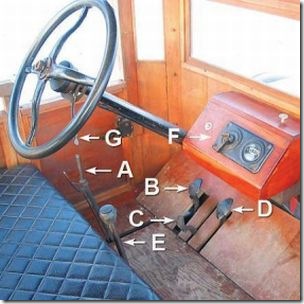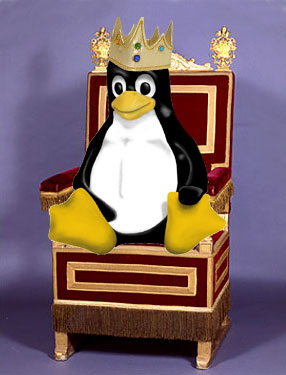In part 1 of this article, I made a quick and handy definition of user interface: Given technology as a black box, user interface is how you tell the black box what you want it to do. In part 2, I listed some things wrong with the current state of user interface, using Google as a prime example.
So we clearly haven’t yet mastered the science of user interface here in the 21st century. But what is it we’re striving towards? What’s the perfect user interface? In, say, a thousand years, when we have unlimited computing power and unlimited energy (like the characters of my novels Infoquake and MultiReal), what kinds of user interface will we be using?
 Let’s take the question one necessary step further: do we really need user interface at all? Or are we evolving toward the point where intelligent tools automatically understand what we’re trying to do? In a thousand years, will the concept of giving commands be obsolete?
Let’s take the question one necessary step further: do we really need user interface at all? Or are we evolving toward the point where intelligent tools automatically understand what we’re trying to do? In a thousand years, will the concept of giving commands be obsolete?
Software developers are taking the first tentative steps in that direction now. Apple’s Steve Jobs has always taken that “benevolent dictator” approach: we’ll decide what you, the user, need to handle, and the machine will just automatically handle the rest. Take disk defragmentation, a software task that only the wonkiest of technowonks has any interest in controlling. There isn’t any standard disk defragmenter for Macs, but that’s not because Mac hard disks never need defragmenting. OS X simply does it for you behind the scenes, as this article on the Apple website makes clear.
Microsoft is moving in this direction too. One of the advantages that Windows users have historically held over Mac users is the fact that it’s generally easier to get under the hood and tweak the gears that make the system work. But that’s going away. Not only because OS X has brought command-line tweaking to the Mac, but because Vista is taking away a lot of tweakability from Windows. Disk defragmentation under Vista is a simple on-off proposition; flip it on, and the OS will handle it as needed. Likewise, throughout the operating system, interfaces that were once cluttered with hierarchical menus and interactive dialog boxes are giving way to much smaller lists of context-sensitive tasks. (For more of my thoughts on this, see old blog posts Don’t Worry, Vista Will Handle It and Look Ma… No Program Menus!)
It’s the same long-term trajectory of user interface we’ve seen in automobiles. Look at the user interface for the Model T (pictured, below; original photo, with explanations and more detail, here). Most modern automobiles have reduced this to a standard set of four controls — the gas, the brake, the steering wheel, and the gear shift. It’s not that the car doesn’t still need all those functions, but now the car handles everything itself. It’s not exposed to the end user. If you believe the so-called experts, we’ll all be zipping around in self-driving robot cars within a generation.
 Follow this trend several hundred years, and where does it lead? I talked previously about elevators that automatically know which floor you’re going to via RFID chips in your apartment keys. Why couldn’t that work elsewhere? Maybe you’ll pull into the Starbucks parking lot and find your usual soy milk decaf latte waiting when you get up to the counter. Maybe the refrigerator will automatically order more eggs from the store when you take the last two out. Maybe the polling station will know that you’re a member of the Christian Coalition and have a ballot all queued up with Mike Huckabee’s name checked when you get up to the voting booth.
Follow this trend several hundred years, and where does it lead? I talked previously about elevators that automatically know which floor you’re going to via RFID chips in your apartment keys. Why couldn’t that work elsewhere? Maybe you’ll pull into the Starbucks parking lot and find your usual soy milk decaf latte waiting when you get up to the counter. Maybe the refrigerator will automatically order more eggs from the store when you take the last two out. Maybe the polling station will know that you’re a member of the Christian Coalition and have a ballot all queued up with Mike Huckabee’s name checked when you get up to the voting booth.
There’s something very unsettling about these scenarios, and it’s not just the potential privacy hazards. Humans want to be in control of our environment; we instinctively resist environments that control us. Not only that, but we quickly grow bored with environments that coddle us. Humans are designed for dynamism, dissatisfaction, and change; despite the stereotype of modern man as couch potato, as a species we don’t handle stasis well.
So we like to be in control of our surroundings. But how much of this control is just feel-good illusion? When you order a hamburger at Burger King, sure, they’ll make it your way — as long as “your way” only involves their nine predefined toppings. And when you ask for lettuce, you can’t control how much, or whether they use shredded iceberg or delicately layered romaine, or whether it comes from West Virginia or Peru or Ecuador. Burger King’s real slogan should be “Have It Your Way, As Long As Your Way Falls Within the Narrow Parameters of Our Way.”
You don’t have much control over Google search results either. Try searching for “Bob Dylan.” You can choose to click on any one of the 25 million results pages you want — but Google determines the order in which they appear, which is tantamount to choosing your search results. (Try selecting the 4,523rd result sometime.) You can select “Advanced Search” and filter those 25 million results a number of ways, but you can’t choose the algorithm that Google uses to determine search results. Nor would you want to, because you’re not a computer scientist specializing in advanced information processing. If Google allowed you complete and utter granular control over every aspect of your search query, you’d either go insane or you’d never get anything done.
So is the Burger King experience a premonition of our future? Do we need to just trust the benevolent dictatorships of Google, Microsoft, and Apple (not to mention Burger King)? Is the future of user interface just a big pie of machine control with a thin crust of user choice on top?
As frightening as that scenario is, the opposite extreme is equally worrisome. It’s the future of total individual control. And boy, would that future suck.
We’re all familiar with the totalitarian sci-fi future where Big Brother boxes you in to a world of limited choices. 1984, Brave New World, Logan’s Run, etc. But what about the world of ultimate choice, where you have to control everything? The world has gotten smaller, our capabilities have grown larger, and the number of choices we have to make is bewildering. Once upon a time, you could choose to be a blacksmith, a farmer, or a priest. Now your career choices expand into the hundreds of thousands. Your parents went to the store and bought apples. Just apples. We go to the store and have to choose between Granny Smith, Macintosh, Fuji, Braeburn, Pink Lady, Red Delicious, Gala, Pippin, and Rome Beauty.
Big deal, you think. So I have to choose between a dozen brands of apples. How’s that a bad thing? It’s not. But what happens in thirty years when you’re expected to specify the size, tartness, color, firmness, ripeness, and pesticide of every piece of fruit you buy? What happens in 150 years when you can bioengineer your own hybrid apple/pear/mangoes right in the store while you wait?
 If you want to see the beginnings of the future of total individual control, look at Linux. The Wikipedia list of Linux distributions catalogs around 200 different flavors of Linux. DistroWatch has much more. And these are just the prepackaged bundles of Linux. The hood’s wide open and the tools are sitting right there on the dash, giving you complete and total freedom to replace anything you like.
If you want to see the beginnings of the future of total individual control, look at Linux. The Wikipedia list of Linux distributions catalogs around 200 different flavors of Linux. DistroWatch has much more. And these are just the prepackaged bundles of Linux. The hood’s wide open and the tools are sitting right there on the dash, giving you complete and total freedom to replace anything you like.
But who can deal with that kind of freedom? Unless you’re the kind of guy who likes to write display drivers in your spare time, you probably don’t have the time, the resources, or the expertise to make informed decisions about all of that. Perhaps one day we’ll all have neural implants to help us cope with all that cognitive processing. But until then, even the Linux geeks rely on consortiums of developers to make those decisions for them.
My point is not to bash Linux or to get into the whole open-source-versus-proprietary discussion — please, God, I don’t want to get into that right now. Rather, I’m pointing out that whether you use a MacBook Pro, a Dell Inspiron with Windows Vista, or a custom box with Kubuntu Linux, you end up relinquishing control. There’s only so much time you want to spend fine-tuning your computer, so instead of letting Microsoft make your decisions for you, you let a worldwide network of open source developers make them. We can argue about whether that makes a better operating system some other time; the point is that the practical effect of too much control on user interface is… giving up control.
So we’ve got the two extremes of User Interface Hell: the world of the benevolent dictator, where your control over your environment is deceptively limited; and the world of ultimate freedom, where you’ve got so much control that your ability to get anything accomplish is equally limited. Both of those extremes are equally unlivable; and you’ll notice that what those futures share in common is a lack of common-sense user interface.
Obviously we need happy mediums. We need to reconcile these two extremes, and simply, reductive user interface is the key.
The machinery that runs your information technology grows more intricate by the day, as does the machinery that powers your car. (Hamburgers, thankfully, seem to have reached an evolutionary plateau.) Despite what some Slashdot readers may fervently wish, I don’t think we’re headed for a future where everyone tweaks their own Linux distribution. If the freedoms we gain from our technology is the time and luxury of tweaking our technology, then we’ve gained nothing.
What often gets overlooked is that user interface isn’t a technological issue; it’s a sociological issue. Bad user interface limits freedom, it limits capability, it disempowers minorities. Think of how much difficulty your grandma has using the ATM. Technology has become too integrated into our society for us to leave people behind through insufficient user interface.
So what form will these perfect user interfaces take? To be continued…